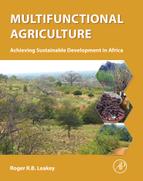Section 4. Tree Domestication
A key challenge for the domestication of agroforestry trees for fruits and nuts centers on the longevity of trees and their outbreeding reproductive system, both of which make tree breeding a slow process. To get around these difficulties, this chapter follows the development of concepts and practices of tree domestication in agroforestry that use the horticultural techniques of vegetative propagation and cultivar selection. This approach has been gaining momentum since its emergence in the 1980s. Using a decentralized farmer-driven and market-led process, this approach seeks to match the intraspecific diversity of locally important trees to the needs of subsistence farmers, product markets, and agricultural environments. The steps of such a domestication process are: selection of priority species; definition of an appropriate domestication strategy; the deployment of germplasm via appropriate low-technology pathways; and the implementation of a participatory rural development. The special focus placed on the use of bottom-up practices is to ensure that benefits flow to the farmers. Nevertheless, this grassroots approach is implemented in parallel with research to understand the extent and patterns of variation that underpin the wise and appropriate use of genetic diversity. Interestingly and importantly, research has found that about 80% of the morphological variation in tree products is found in every village population. This finding is fundamentally important for the success of the decentralized tree domestication strategy, as well as its close affiliation to a commercialization and value-adding strategy that promotes the formation of a local value chain that seeks to maximize income generation in local and regional markets, as part of a strategy for sustainable rural development.
Over the first two decades of this program, work has progressed on more than 50 tree species around the world with an expanding research agenda characterizing traits important for domestic fresh-food consumption as well as on the chemical and physical composition of products for food and nonfood industries. Looking to the future, suggestions are made for further development and expansion of both the science to underpin agroforestry tree domestication, and for applied research in support of development programs to enhance the livelihoods of poor smallholder farmers worldwide. In parallel with grassroots cultivar development, modern molecular techniques provide understanding of the genetic structure of variation in a number of traditionally important indigenous food trees. Together they open up opportunities for novel trait combinations to meet a wide range of human needs. Thus, at one end, this program has a highly effective and tested, decentralized approach to indigenous tree domestication for the relief of food and nutritional insecurity, poverty, social injustice, environmental degradation, and climate change at the local level; while at the other end, genomic studies ensure that the genetic resource management of indigenous species is based on the latest understanding of the fundamentals of genetic diversity. Together, this approach paves the way for the diversification of domesticated species in tropical agriculture to ensure that agriculture satisfies the needs of billions of individual people as well as the global needs of humanity for the wise management of our planet. In the latter context, the domestication of these tree species also has a key role in the “carbonization” of agriculture and hence in the mitigation of climate change, as well as in the conservation of natural resources and the complex series of interactions between them and living things.
